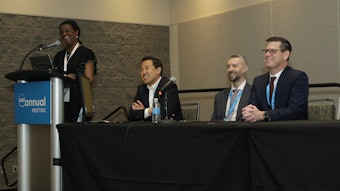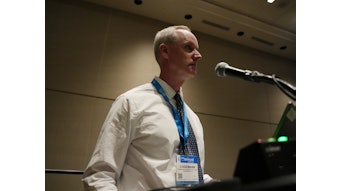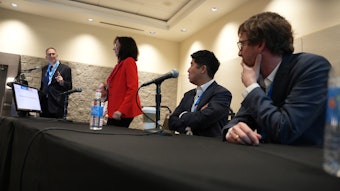How to attain the gold standard in laser treatments
Preparation and precision are key for proper post-laser care.

U026 – The Do’s and Don’ts of Fractionated Resurfacing Laser
3:30-4:30 p.m. | Friday, March 7
Location: W314B
Fractionated resurfacing laser remains the gold standard for treating wrinkles, scars, and other textural irregularities. If performed correctly and safely, it can be life-changing for patients.
Yet, there’s more to know about this approach, including how to identify disease candidates and prevent potential complications. All that and more will be the focus of today’s session, U026 – The Do’s and Don’ts of Fractionated Resurfacing Laser.
“The primary goal of fractionated resurfacing lasers is to rejuvenate the skin by creating controlled microthermal zones of injury, stimulating the body’s natural healing process,” said session director Gabriela Maloney, DO, FAAD, a dermatologist with Forefront Dermatology in Brookfield and Oconomowoc, Wisconsin. “This approach promotes collagen remodeling and regeneration while leaving surrounding tissue intact, which accelerates healing and minimizes downtime.”
Fractionated lasers debuted in 2000 as an evolution of traditional ablative CO₂ laser technology. They can also correct pigmentation irregularities, such as sunspots, melasma, and post-inflammatory hyperpigmentation, while enhancing overall skin tone and radiance.
According to Dr. Maloney, these lasers are widely used for scar revision, including acne scars, surgical scars, and stretch marks, as well as for mild skin tightening to address early signs of laxity. By offering a customizable balance between efficacy and recovery time, fractionated resurfacing lasers provide patients with noticeable, long-lasting improvements in skin health and appearance, she said.
Careful consideration
Despite all the attractive benefits, proper post-treatment care is essential, Dr. Maloney said. After CO₂ fractionated resurfacing, certain protocols ensure optimal healing and minimize complications.
First, dermatologists should emphasize with their patients the importance of a gentle skincare routine. For example, Dr. Maloney tells patients to cleanse with a mild, non-foaming cleanser and use sterile saline or diluted vinegar soaks to reduce inflammation, soothe the skin, and prevent infection.
Applying a thick occlusive, such as petroleum jelly or a specialized post-procedure balm, is critical to maintain a moist wound-healing environment, which accelerates recovery and reduces scarring risks. Likewise, sun protection is paramount, she said.
“Advise patients to avoid direct sunlight, wear broad-spectrum sunscreen (SPF 30+), and use physical barriers like wide-brimmed hats once the skin barrier has healed,” said Dr. Maloney. “To reduce redness and swelling, recommend using cool compresses or an over-the-counter hydrocortisone cream sparingly, if approved. Oral antihistamines may also help alleviate itching during the recovery phase. Hydration and avoiding smoking will further support collagen remodeling and overall healing.”
Follow-up appointments are necessary to monitor progress, address concerns, and guide the reintroduction of active skin care products like retinoids or acids, usually after four to six weeks, she said. For patients who have higher Fitzpatrick types or a history of post-inflammatory hyperpigmentation, Dr. Maloney said dermatologists should consider prophylactic topical agents, like hydroquinone or a mild steroid, during the recovery phase.
Setting realistic expectations and providing clear, detailed instructions can greatly enhance patient satisfaction and safety following CO₂ fractionated resurfacing.
Pitfall potential
To detect potential pitfalls and reverse complications, Dr. Maloney said it’s crucial for dermatologists to thoroughly evaluate patients’ medical history, skin type, and lifestyle factors before initiating treatment. A detailed pre-procedure consultation should screen for contraindications, such as active infections, autoimmune conditions, or recent use of isotretinoin, which can impair healing. Understanding the patient’s Fitzpatrick skin type is essential as well, she said, as darker skin tones are more prone to post-inflammatory hyperpigmentation (PIH).
Dermatologists should also consider previous treatments and procedures, as these may influence skin sensitivity and healing capacity. During the procedure, Dr. Maloney recommends using conservative settings, especially for higher-risk patients, and adhering to evidence-based protocols to prevent complications such as burns, scarring, or delayed healing.
Formulating effective prevention and treatment strategies requires proactive measures, she said. This includes prescribing antiviral prophylaxis for laser resurfacing patients with a history of herpes simplex and recommending sunscreen and topical depigmenting agents (e.g., hydroquinone) for PIH-prone individuals. After a procedure, regular follow-up visits allow for early detection of complications such as infections, erythema, or hypertrophic scarring.
Changing course
In the event of reversal, Dr. Maloney said prompt interventions tailored to the complication are essential. For example, she recommends treating PIH with topical retinoids or chemical peels, addressing erythema with pulsed-dye lasers, or managing infections with appropriate antibiotics.
“Ultimately, clear communication and individualized care plans help dermatologists navigate complications effectively, ensuring both patient safety and satisfaction,” said Dr. Maloney.











